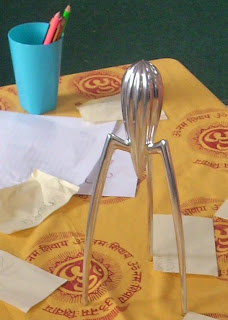 One of the frameworks I regularly share with teachers is that of the Learning Pit, a model that explains how and why challenge is necessary for learning. Having first heard Dr John Edwards in 2001 using a "pit" to explain how organisational growth more often than not involves getting worse before getting better, I thought that the metaphor was an ideal way to explain to my students why I was consistently making things more difficult for them. Since then I have developed the idea into the following four-stage lesson plan:
One of the frameworks I regularly share with teachers is that of the Learning Pit, a model that explains how and why challenge is necessary for learning. Having first heard Dr John Edwards in 2001 using a "pit" to explain how organisational growth more often than not involves getting worse before getting better, I thought that the metaphor was an ideal way to explain to my students why I was consistently making things more difficult for them. Since then I have developed the idea into the following four-stage lesson plan:STAGE 1: IDENTIFY THE KEY CONCEPT
The learning pit always begins with an important concept, since it is through conceptual analysis that students gain an understanding of their world. Example concepts include: art, bullying, culture, democracy, existence, growth, indentity, justice, knowledge, language, music, number, originality, poetry, questions, reality tv, science, tourism, and so on.
STAGE 2: CHALLENGE
In July 2008, Professor John Hattie began an address on behalf of his Visible Learning Laboratory in Auckland with: "The major message from my work with 240m students, 800+ meta-analyses, 50,000+ studies is... Challenge Challenge Challenge Challenge Challenge". Stage two of the learning pit is concerned with just that: challenging students to think more deeply, purposefully, critically and creatively.
STAGE 3: CONSTRUCT
This is the point at which students co-construct an undersanding of the key concepts through continued dialogue and study with each other. According to many notable educational theorists such as Lev Vygotsky, Jean Piaget and John Dewey, there is no such thing as knowledge "out there" independent of the knower, but only knowledge we construct for ourselves as we learn. Stage three recognises this by creating the conditions necessary for meaningful dialogue.
STAGE 4: REFLECT
If you reflect on anything you have learned, you soon realise that it is the product of repeated exposure and thought. Thus, stage four is concerned with students revisiting and reflecting upon their learning journey.
Notes
- The Learning Pit will be published in my new book, Challenging Learning, this autumn. To reserve your copy, please click here
- For an article covering the background, lesson ideas and outcomes of the Learning Pit, click here
- The photo attached to this posting comes from Lacey McCarthy,whose Year 2 students at Douglas Park School in Masterton, New Zealand have been using the Learning Pit to deepen their learning.










